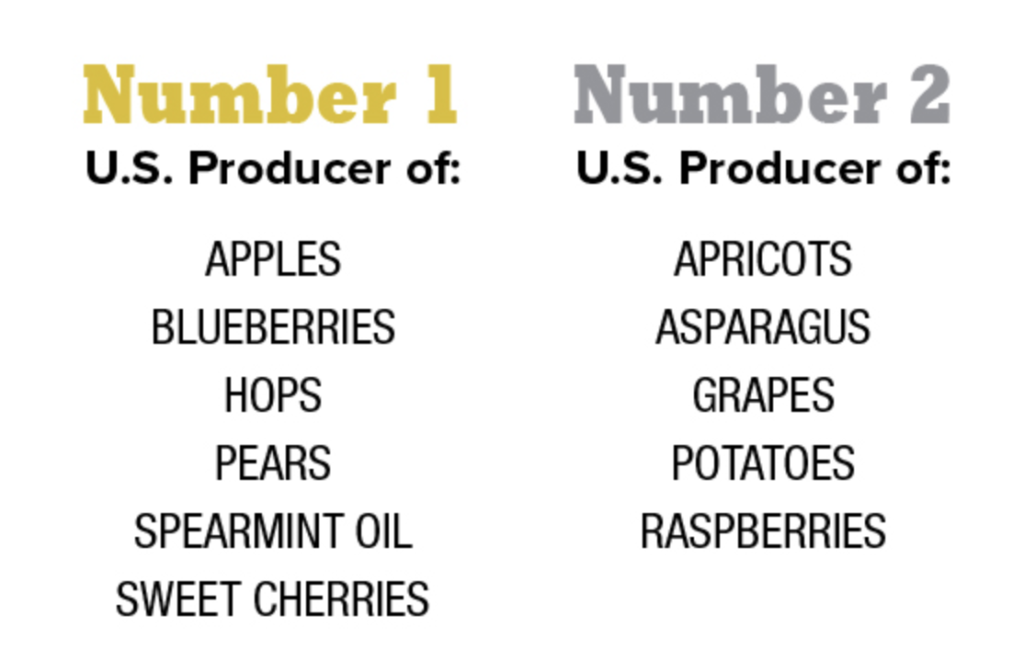Making it easy as pie for the media to cover your story
For a fun-filled year I worked as a program coordinator for the Clean Plant Network (CPN).
The program focuses on testing and cleaning up viruses out of fruit trees, hops and wine grapes. Sexy, huh! Well, actually, it is… in an economic impact kind of way.

Let’s say a grower plants a couple hundred acres of new apple trees. It’s going to take five years for those trees to get big enough to produce apples. After the five years the grower goes out to harvest but finds out his apple trees have a virus the impacts the taste and the look of the apple. Goodbye apples!
But we’ve just started with the economic impact. The grower has to bulldoze the virus infected trees out, comb through the soil to pull out any remaining root that can spread the virus to new trees. Then they use chemicals to clean out any leftover virus in the soil. In some cases, the soil has to sit dormant before new trees can be planted.
The grower has lost time and money. And it’s going to take more time and money to get that orchard planted and producing again. (This time, hopefully, with “clean,” virus-free trees.)
When you consider how big agriculture is in this state, you start to realize how important clean plants are. Here are some quick stats from the Washington State Department of Agriculture.

So, the Clean Plant Network plays an important role in six of Washington’s biggest crops; apples, hops, pears, sweet cherries, apricots, and grapes.
Okay Terri, we get it. Agriculture is big in Washington.
Well, my job involved letting growers, nurseries, stakeholders, the government and the public know what the Clean Plant Network does to make agriculture so successful.
Tactic #1: Using news releases to get the CPN’s “clean” work out there
I used several different tactics to get media covered for the CPN. I wrote news releases posted on Washington State University’s College of Agricultural, Human, and Natural Resource Sciences web site. Other publications could use that material in their own publications.
For example, I wrote this news release about CPN’s work in battling hop stunt disease.
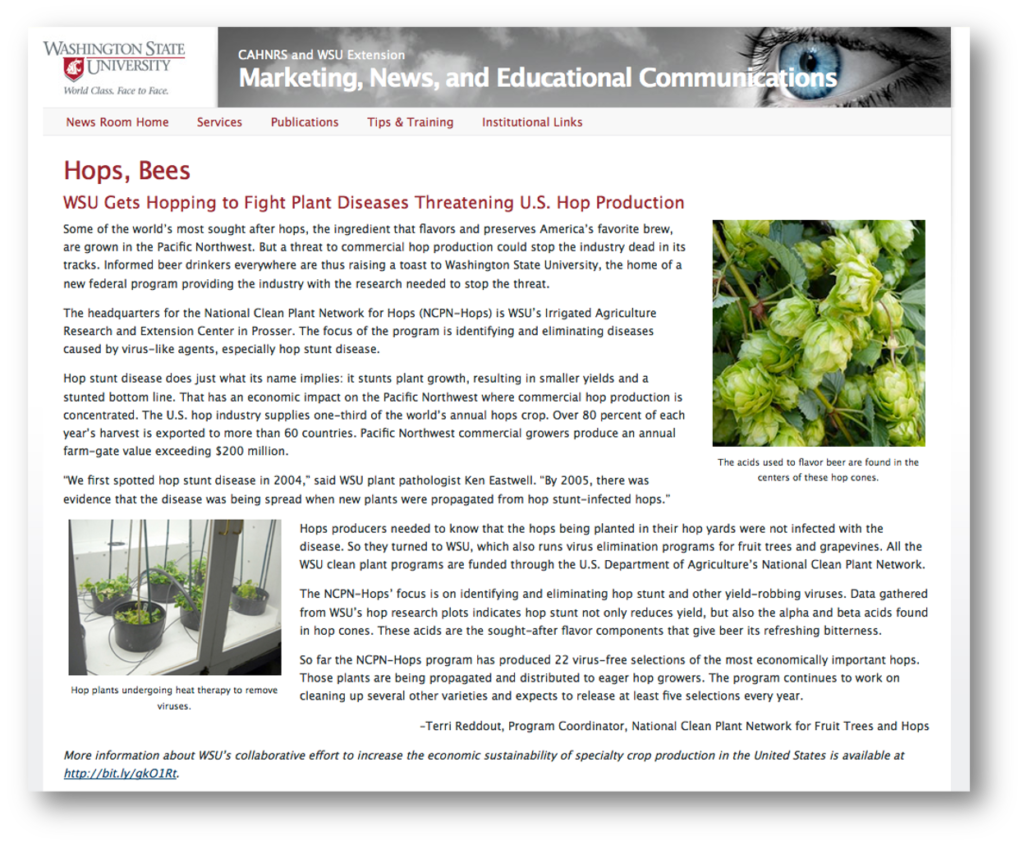
A few weeks later, Plant Health Progress, a journal for scientists and industry leaders, printed my news release word-for-word.
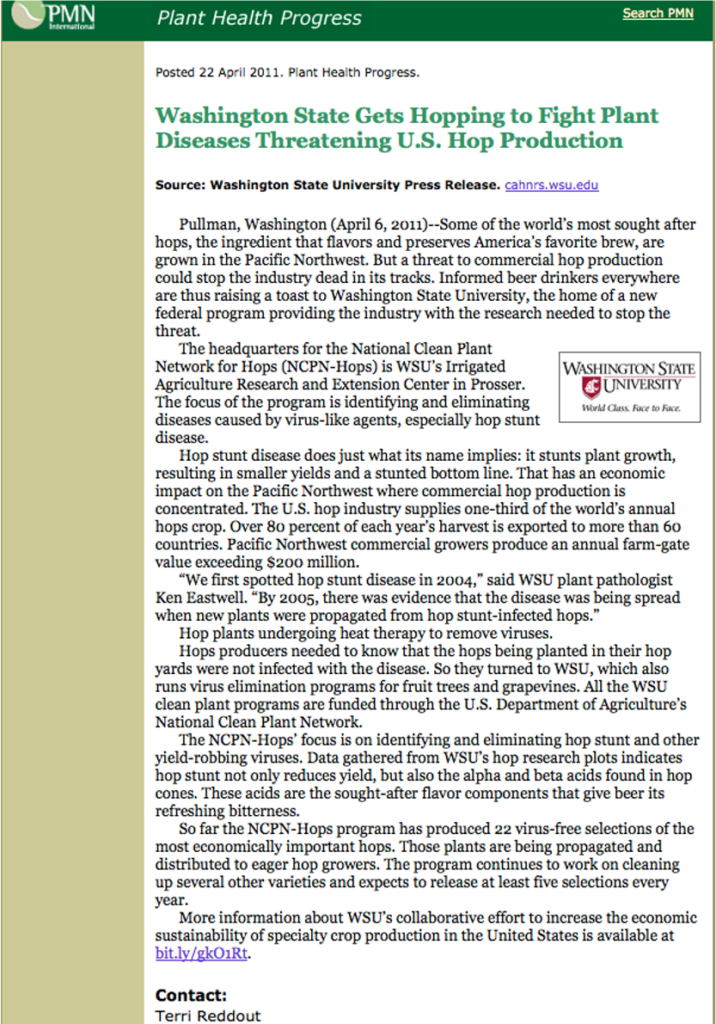
The same thing happened with many of my news releases…. I just don’t have visual proof!
Tactic Number 2: Pitching stories
Pitching a story is different from writing a news release in several different ways. It’s more directed toward a particular reporter rather than the media in general. It’s more specific to that particular media outlet’s format or style. And a good story pitch makes it real easy… and inviting… for the reporter or news outlet to cover your story.
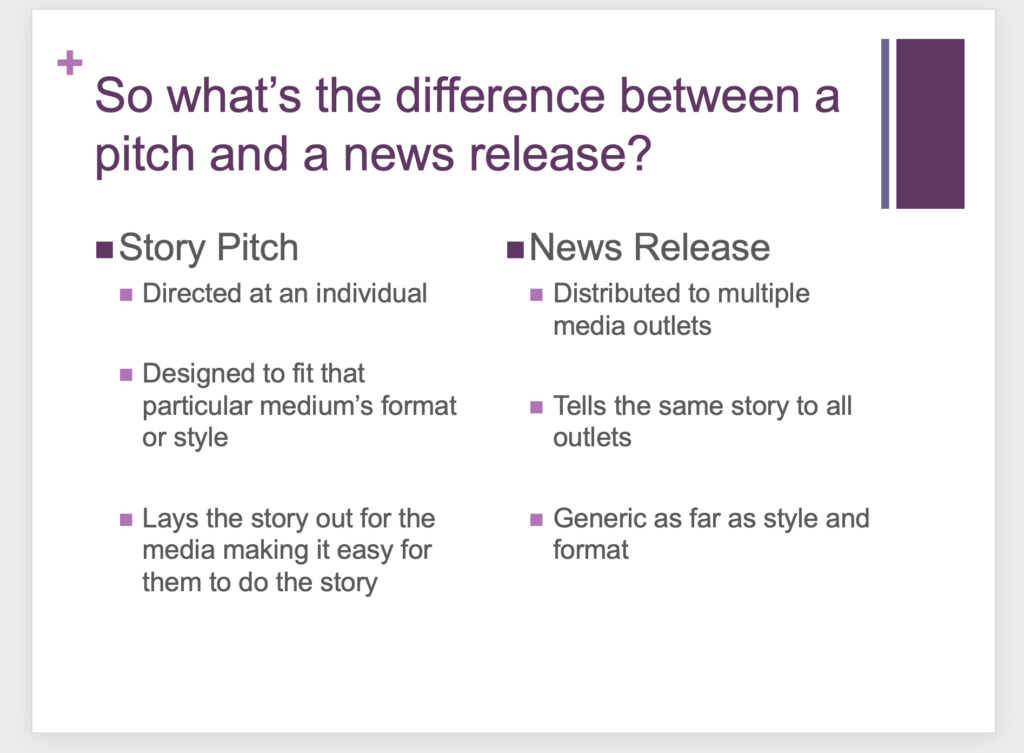
So, what is a story pitch? It’s like a baseball pitch… sorta…
Let’s say you’re a Mariner’s pitcher. It’s your job to pitch balls at the opposing teams hitters. In our little scenario, let’s pretend the pitcher is a PR professional. And let’s pretend the opposing teams batters are news reporters.
When the pitcher steps onto the mound, his job is NOT to strike the news reporter out. His job is to make sure the news reporter hits a home run!

To continue our scenario a bit further, the pitch our pitcher throws at the newspaper reporter will be a different pitch from the television reporter. The pitch he throws at the radio reporter will be different from the pitch thrown to the sports blogger.
Warming up for the pitch
In order for our PR team to be successful, we need to scout out the reporters to find out what kind of pitch is easiest for each one to hit. To do that you need to investigate the reporter’s “home field.”
Step 1: Establishing relationships
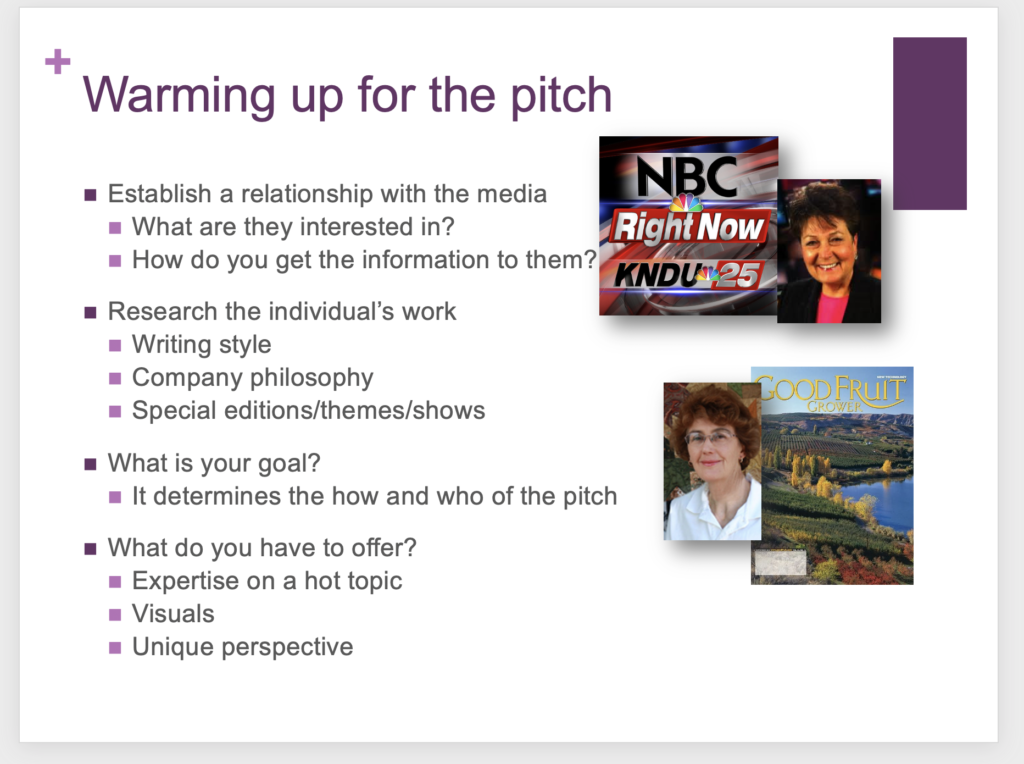
When I started at CPN, I stopped in to get reacquainted with the KNDU news director, Christine Brown. Christine and I met several times before and she hired some of my students from Weber State.
When I met with Christine she invited the newscast’s executive producer. I told her about the CPN and why her viewers would be interested. She then pounded me with questions relating to agriculture, but not necessarily my program. I told her, I would go back to the research station and see what I could find out. And I did. I provided her with names and numbers of experts her reporters might want to contact for future stories.
Did that list of experts help promote the CPN? No. But, it did prove to Christine and her staff that I could be a reliable source of information when it comes to agriculture? Yes. Because we built that relationship, her people paid attention to me when I pitched CPN stories. Basically, it turned out to be a “I’ll scratch your back if you’ll scratch mine” relationship.
Step 2: Knowing the obstacles your reporter faces and showing them away around those obstacles

Prosser is home for the WSU Research Center. Everyone in town knows someone who works tat the research center, but nobody knows what they do out there!
The Prosser Record Bulletin publishes twice a week. At the time they had one and a half reporters. The half reporter also edited the paper. The reporter had just started and didn’t know anything about the Prosser Research station.
I sent her an email saying I heard she had just started at the newspaper and I had just started at the research station. I wrote that I’d love to take her on a tour of the research station and… I promised her she’d leave the station with a story to write immediately, along with leads to at least two other stories.
I recognized that as the sole reporter, she didn’t have time to take tours that didn’t result in a story. She needed to walked away from the tour with a story in hand. She did. She immediately wrote a story about CPN. She also walked away with four leads for future stories with the grapes and hop folks.
Step 3: Knowing your reporter’s style and audience
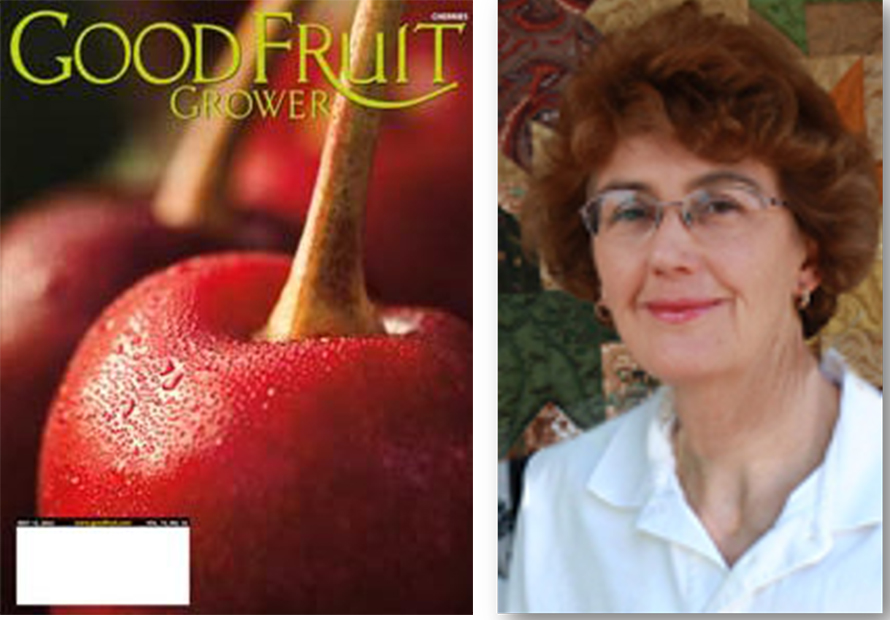
The Good Fruit Grower is THE way to reach fruit growers. It’s in every orchardist’s and grape grower’s mailbox each month. It has a very specific audience. Knowing the reporter’s audience and pitching stories that fit with that audience is key. At the time, the Good Fruit Grower had several reporters, but Geraldine Warner covered most of the fruit stories in the Pacific Northwest.
I knew not to pitch “warm and fuzzy” stories to Geraldine. The stories I pitched to Geraldine had to have a scientific edge. That’s because the magazine focuses on the science of fruit and grape growing. After talking with her editor, I learned the best way to reach Geraldine was via email. For some reporters it’s Twitter or a text or even a phone call. But for Geraldine I sent emails. Often, the only response I got in return would simply read: “Thank you.” Nothing else. Many times I never knew if she’d follow up on the story until I saw in the magazine.
For example, before I left CPN to come to CWU I sent Geraldine an email giving her a heads up on a possible story several months away. She wrote back: “Thank you.” About six weeks later, I found this little blurb in the back of the magazine. She put together a preview story, “Faster virus detection,” for a story that would happen several months later.
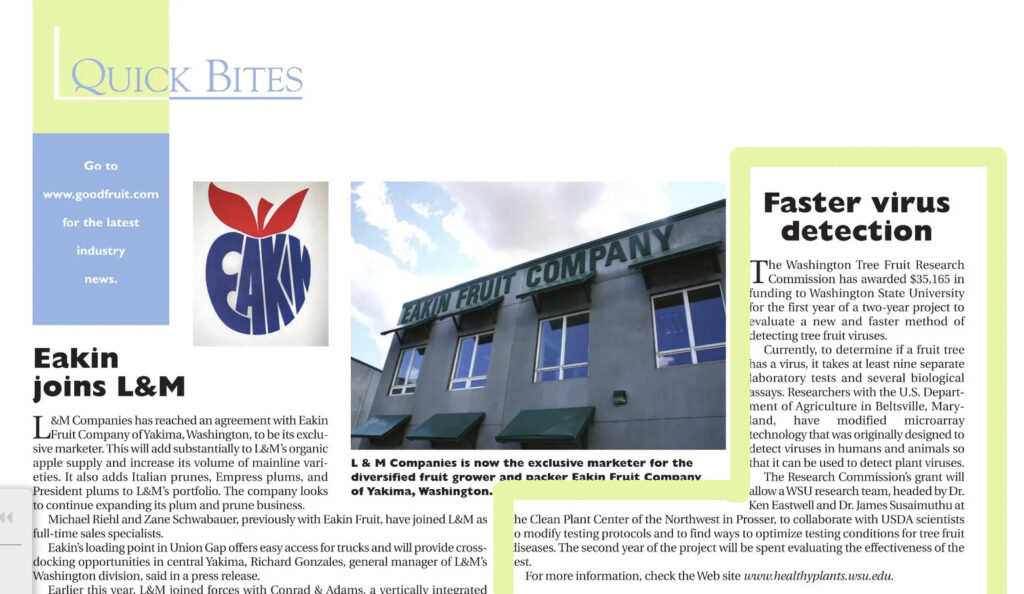
Knowing your goals, helps you choose which hitter will hit a home run with your pitch
In the spring, the CPN fills a greenhouse with 30,000 indicator trees. A group of men with very sharp knives take bits of tree with suspected viruses and “bud” them onto one of the indicator trees. The two pieces of tree grow together. After a few weeks the indicator plant will tell the scientists whether the suspected tree has a virus. How? The leaves on the indicator plant get funny leaves covered with colored blotches.
This is an important event for the CPN. We wanted people to know about it. So, I pitched the same story to two different reporters. Each pitch took a different angle.
The pitch I made to the TV station started with visuals. I told them I had a greenhouse filled with 30,000 trees. A group of men with sharp knives would flash their knives around to quickly bud tree parts together. Eventually the indicator plants will tell scientists if a tree has a virus. If it has a virus, it’s sent to a lab that looks like the set of a sci-fi movie.
I painted a picture of what the story would look like visually. They bit.
The reporter they sent out had been there for a while. I knew his contract would end soon and he’d be looking for a new job. I asked him if he had any good stories to put on his reporter reel. He gave me a mediocre response. I told him, he’d leave the greenhouse with a reel-worthy story. And he did.
In fact, he even called me that afternoon to read the script to me. (Something journalists should never do!) But I listened. I cleared up a couple of little mistakes and he put together an excellent story that ran that night near the top of the newscast.
Same story, different pitch
I also called the Prosser newspaper. I told them about the virus budding, but a gave them a different angle. I told them the station had hired several local people to help with the budding. She came out and did the story about how this particular project generated jobs for people in the Prosser area. Plus images of the workers using those knives so quickly made for a great front page picture!
A different story with two pitches
One of the mangers at the CPN planned a trip to Washington, D.C. during cherry blossom time. His travel plans included making a stop to look a tree he had helped “clean.” A sister city in Japan donated the tree to the U.S. It immediately came to CPN. We discovered viruses almost dripping off the branches! Bill and his crew cleaned up the trees so they could be planted along the Washington Mall. I told Bill to take a picture of himself next to the tree. He did.
I pitched the story to the local paper as a “feel-good, local man does good” story. They used the picture and interviewed Bill for a story that ran on the second page.
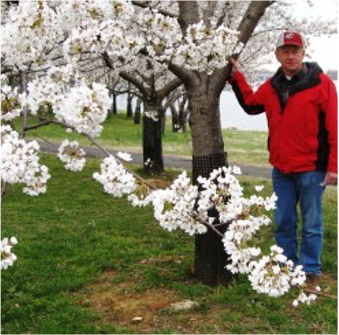
I pitched the story to a TV station saying a local man visited some trees that a project in Prosser helped clean up. I suggested they get video of the cherry trees in bloom from the network feed and combine those with the still pictures Bill brought back. They sent a reporter out to interview Bill and ran the story on air that night. The web version of the story is still online.
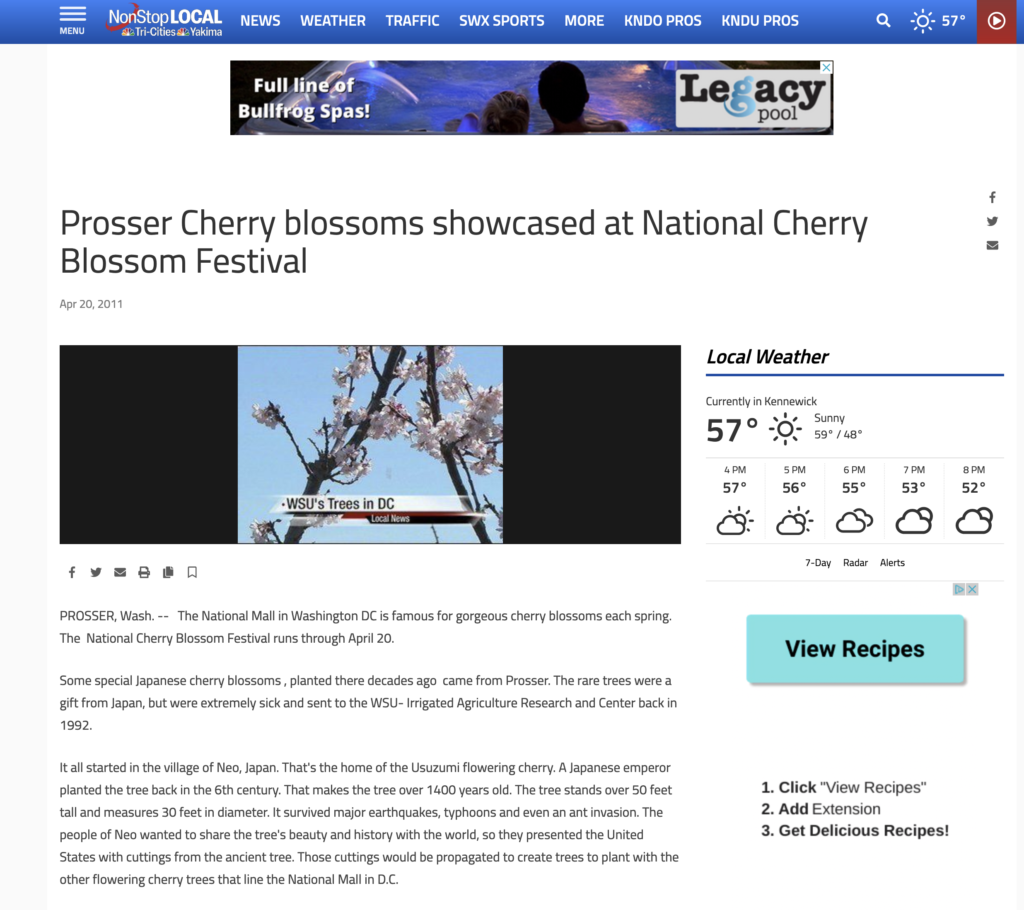
One more example…
For a while the Prosser station manager, pulled me off my CPN job to drum up media coverage for other projects going on at the research center. I successfully pitched one story about the weather station that provided weather conditions specifically for farmers. It has some cool video and the tv station’s audience included a LOT of farmers.
My favorite pitch had to do with a book on butterflies written by one of the entomologists (scientists who study bugs). The book had hundreds of gorgeous pictures in it. And entomologist had a super cool Australian accent and he didn’t act like your stereotypical stuffy Ph.D.

I decided to pitched the story to the morning show at KNDU. I knew their morning reporter had to do 4 live hits that ran 3-4 minutes long.
My email told them that a local scientist co-authored the be-all, end-all book about butterflies in the Pacific Northwest. I suggested the reporter spend one live hit talking about the book, and a second live hit talking about butterflies about to go extinct near Moxee. The third and fourth live hits could focus on another project Dr. James had underway. It had to do with using native plants to beautify local vineyards… AND attract beneficial bugs.
From experience, I learned they couldn’t send out a live signal from Prosser, so I suggested we could bring the butterfly show to them.
A separate email went out with some samples of pictures from the butterfly book. Perhaps they could use those pictures to promote the live shot? (Hint, hint.)
They bit right away. Then, in the flurry of emails that followed, Dr. James suggest he could hatch a butterfly and have a live butterfly sitting on his finger during one of the live hits. I asked him how he could keep it from flying away. He told me he’d keep it in a cooler. Once he took it out and put it on his finger, it would take two to three minutes for the butterfly to warm up enough to fly away.
The station had visuals. They knew what topics Dr. James could talk about and they all related to the area (proximity). Plus, we threw in a live butterfly, that would fly away near the end of the segment. Now… that’s good television!
They did this live morning show hit right after I left CPN to come to CWU. They tell me it went smoothly and viewers reacted positively to the segments.
Okay, Terri, enough with the war stories. What’s the lesson to be learned here?
The lesson is simple. Know your reporters and how they work. Know their audience. Know their reporting style. “Scout” out the reporters in your market, just like the big league teams scout out their opponents.
This means you’ll have to watch a newscast or a read a newspaper. Maybe even more than once. Learn how to throw the right pitch to allow that reporter to hit a home run story. If you learn how to pitch, you can land lots of stories for your clients. And that’s a big win!
A few hints for making a pitch
- Timing is everything. Try tying your pitch to something going on in the news. (Umm… remind you of a certain news release you just wrote?)
- Timing is everything – Part 2. Know when the deadlines are and don’t try pitching a story when the reporter has an editor or producer breathing down their necks.
- Know your media. Television will need video and live interviews. Newspapers will need photo ops and access to people for interviews. A radio show or podcast may need an expert who could answer questions and talk about the topic for 30 minutes or more. Know your media. Know what they need. Then give it to them!
- Keep your pitch short and sweet. Email the basics. Give them links to the details.
- Think visually. Television doesn’t exist without visuals. Newspapers will decide whether to run or where to place a story based on the strength of the pictures. Set up opportunities to get good visuals.
- Respond and follow up. Nothing, I mean nothing, can irritate a journalist more than a PR person who doesn’t respond or responds too late.
One last thing…
So, why is it important to get the news media to cover your client’s story? You might remember a couple of quotes from Quote Quiz #1.
“Publicity is absolutely critical,” Richard Branson said. “A good PR story is infinitely more effective than a front-page ad.”
“Advertising is saying you’re good,” Jean-Louis Gassee said. “PR is getting someone else to say you’re good.”
Your Assignment
- Think about the client you picked for the media kit assignment. Come up with a list of at least three media outlets you could potentially pitch stories to.
- Be realistic. ABC News will not send a reporter crew out to cover the grand opening of your mother’s dog grooming business.
- What kind of stories would you pitch to each media outlet?
- How would your pitches differ between each media outlet?
- Share with me your reaction, your thoughts, your concerns, your questions about story pitches.
